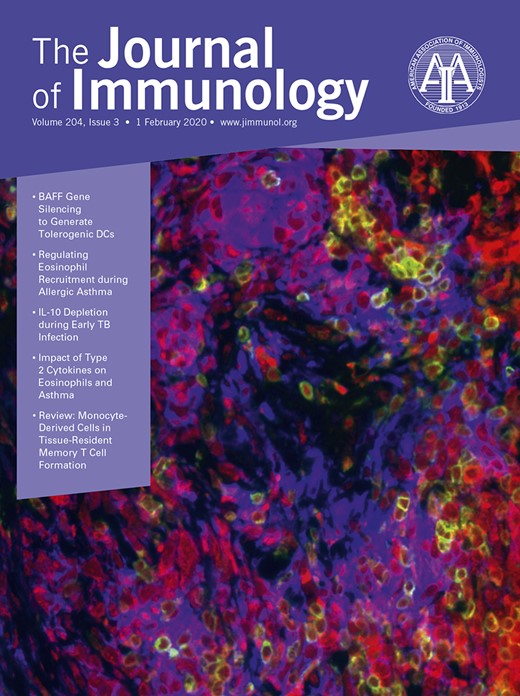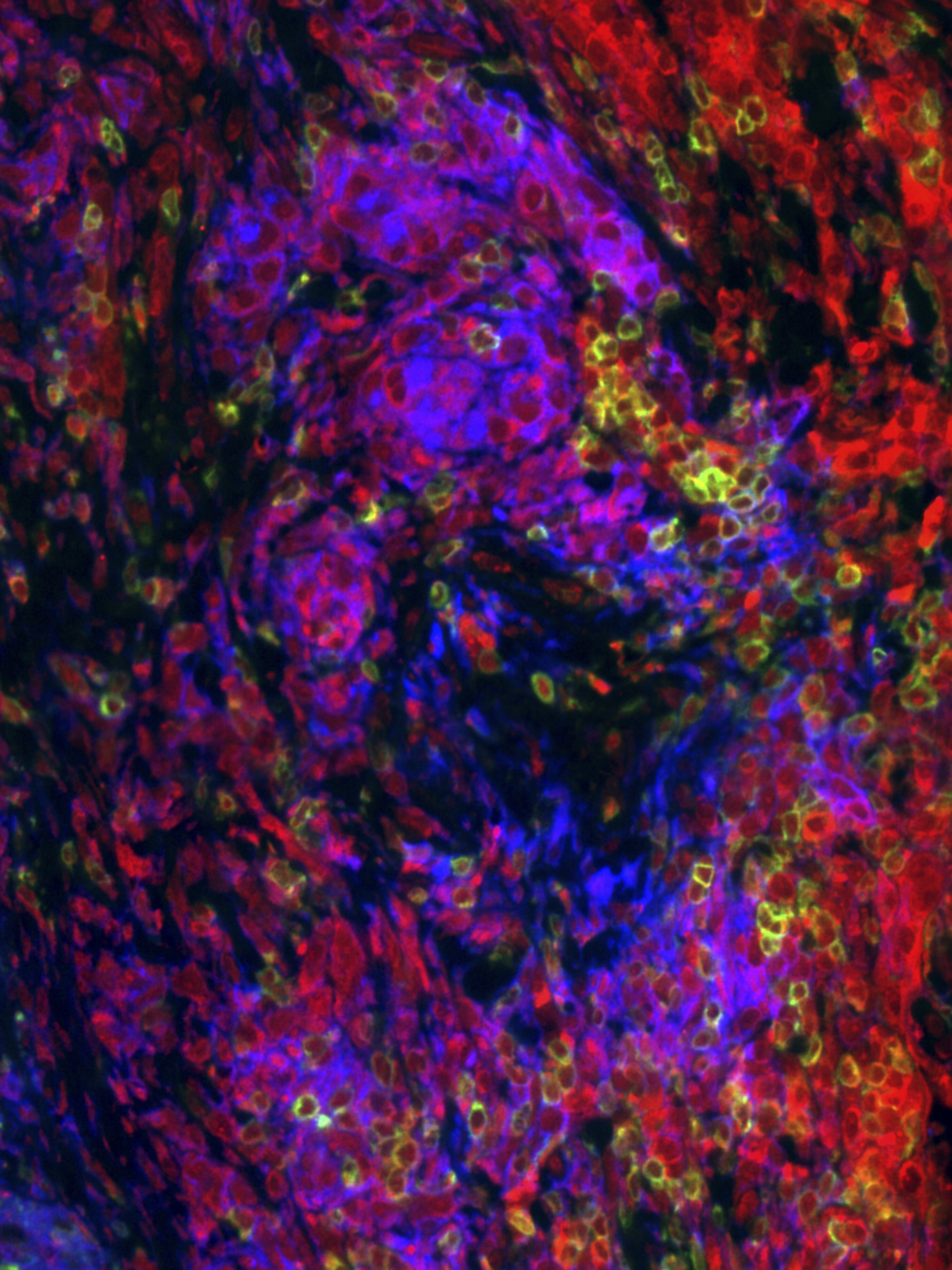
Cover image

On the cover: Immunohistochemistry of a Mycobacterium tuberculosis granuloma during early infection. IL-10 receptor (red) is primarily found on macrophages (blue) rather than on T cells (green), indicating that IL-10 acts primarily on macrophages in granulomas. Wong, E. A., S. Evans, C. R. Kraus, K. D. Engelman, P. Maiello, W. J. Flores, A. M. Cadena, E. Klein, K. Thomas, A. G. White, C. Causgrove, B. Stein, J. Tomko, J. T. Mattila, H. Gideon, P. L. Lin, K. A. Reimann, D. E. Kirschner, and J. L. Flynn. 2020. IL-10 impairs local immune response in lung granulomas and lymph nodes during early Mycobacterium tuberculosis infection. J. Immunol. 204: 644–659.
Volume 204, Issue 3, February 2020
Top Reads
Top Reads
Brief Reviews
Monocyte-Derived Cells in Tissue-Resident Memory T Cell Formation
Antigen Recognition and Responses
Maturation of an Antimicrobial Peptide Inhibits Aeromonas hydrophila Infection in Crayfish
PcnAMP is processed by endogenous trypsin into the short active form.
PcnAMP destroys the bacterial cell membrane integrity in vitro.
PcnAMP is important in host resistance to Aeromonas hydrophila infection.
Cross-Reactivity with Self-Antigen Tunes the Functional Potential of Naive B Cells Specific for Foreign Antigens
All populations of foreign Ag-specific B cells cross-react with self-antigens.
Moderate cross-reactivity to self-antigen promotes optimal naive B cell response.
cDC1 IL-27p28 Production Predicts Vaccine-Elicited CD8+ T Cell Memory and Protective Immunity
Twelve-hour cDC1 IL-27p28 expression predicts adjuvant-elicited CD8 T cell memory.
cDC1 IL-27p28 expression uniquely stratifies T cell–inducing adjuvants.
Autoimmunity
Tolerogenic Dendritic Cells Generated by BAFF Silencing Ameliorate Collagen-Induced Arthritis by Modulating the Th17/Regulatory T Cell Balance
BAFF-silenced DCs exhibited an immature and tolerogenic phenotype.
BAFF-silenced DCs alleviated mouse CIA by modulating the Th17/Treg balance.
BAFF might be a promising genetic target to generate tolDCs for RA treatment.
IL-9 Controls Central Nervous System Autoimmunity by Suppressing GM-CSF Production
IL-9R−/− mice develop severe EAE with increased frequency of GM-CSF+ CD4+ T cells.
IL-9R−/− DCs induce GM-CSF in CD4+ T cells and contribute to disease worsening.
Clinical and Human Immunology
Impact of Early Antiretroviral Therapy Initiation on HIV-Specific CD4 and CD8 T Cell Function in Perinatally Infected Children
HIV-specific T cell responses persist despite long-term viral suppression.
Timing of ART initiation impacts the quality of the HIV-specific T cell responses.
Baseline PBMC transcriptome is different in HIV-infected children treated early.
Immune Regulation
Single and Synergistic Effects of Type 2 Cytokines on Eosinophils and Asthma Hallmarks
IL-5 regulates development in BM and accumulation of eosinophils in the lung.
IL-13 induces airway eosinophilia, AHR, and goblet cell metaplasia.
Development and transmigration of eosinophils are synergistically affected by both cytokines.
Functional Expression of the P2X7 ATP Receptor Requires Eros
The P2X7 receptor requires Eros as a chaperone to be expressed at plasma membrane.
The ATP-triggered IL-1β secretion in macrophages is strongly reduced without Eros.
Ca2+–Calcineurin Axis–Controlled NFAT Nuclear Translocation Is Crucial for Optimal T Cell Immunity in an Early Vertebrate
T cell signals trigger activation of multiple events in the teleost Ca2+–NFAT axis.
Tight regulation of Ca2+–NFAT is pivotal for teleost T cell activation and function.
Ca2+–NFAT is a primitive regulatory strategy that emerged in teleost T cells.
CD4+ T Cell–Derived NGAL Modifies the Outcome of Ischemic Acute Kidney Injury
Kidney CD4 T cells significantly increase Lcn2/NGAL expression following IR injury.
CD4 T cell Lcn2/NGAL protects against IR-induced AKI.
Lcn2 expression increased in ischemic CD4 T cells from human kidney.
Differential Induction of SOCS Isoforms by Leishmania donovani Impairs Macrophage–T Cell Cross-Talk and Host Defense
L. donovani induces SOCS1 in BMMфs by PI3K/Akt/Egr2 and IDO/kynurenine pathway.
PGE2 from infected BMMфs activates cAMP/PKA-mediated SOCS3 expression in T cells.
This inhibited STAT1- and STAT4-mediated IFN-γ and IL-12 synthesis in immune cells.
Immunotherapy and Vaccines
Tuning Subunit Vaccines with Novel TLR Triagonist Adjuvants to Generate Protective Immune Responses against Coxiella burnetii
Novel TLR triagonist platforms have adjuvant activity in vivo.
The TLR triagonist adjuvants tune immune responses to subunit vaccination.
Naringenin Enhances the Antitumor Effect of Therapeutic Vaccines by Promoting Antigen Cross-Presentation
Enhanced Ag cross-presentation by naringenin is due to moderate ROS induction.
Naringenin potentially facilitates therapeutic vaccines against cancers or viruses.
Flavonoids manipulate intracellular ROS, making them excellent immunomodulators.
Infectious Disease and Host Response
Brucella Infection Regulates Thioredoxin-Interacting Protein Expression to Facilitate Intracellular Survival by Reducing the Production of Nitric Oxide and Reactive Oxygen Species
Brucella decreased TXNIP to promote its intracellular growth in macrophages.
Reduced TXNIP promotes Brucella intracellular growth via reduction of NO and ROS.
The expression of iNOS and the production of NO were dependent on the Brucella T4SS.
IL-10 Impairs Local Immune Response in Lung Granulomas and Lymph Nodes during Early Mycobacterium tuberculosis Infection
IL-10 is not detrimental to early M. tuberculosis infection outcome.
Lack of IL-10 influences immune responses and fibrosis in granulomas.
Modeling predicts that prolonged lack of IL-10 leads to improved infection outcomes.
Neutrophils Enhance Their Own Influx to Sites of Bacterial Infection via Endosomal TLR-Dependent Cxcl2 Production
Neutrophils produce high levels of Cxcl2 in response to whole bacteria.
Cxcl2 production depends on sensing of bacterial nucleic acids by TLR7, 9, and 13.
Cxcl2 acts autocrinously to enhance antibacterial activities and its own production.
Innate Immunity and Inflammation
Mycobacterium tuberculosis Lipoarabinomannan Activates Human Neutrophils via a TLR2/1 Mechanism Distinct from Pam3CSK4
Mtb LAM stimulates neutrophil cytokine production via TLR2/1 signaling.
Mtb LAM–elicited neutrophil responses are distinct from the TLR2/1 agonist Pam3CSK4.
Regulation of Eosinophil Recruitment and Allergic Airway Inflammation by Tropomyosin Receptor Kinase A
Eosinophilia is a characteristic feature of allergic airway inflammation and asthma.
TrkA activation by eotaxin-1 promotes eosinophil migration and airway inflammation.
Inhibiting TrkA kinase mitigates airway eosinophilia and suppresses a Th2 phenotype.
Antiviral Inflammation during Early Pregnancy Reduces Placental and Fetal Growth Trajectories
dsRNA induces an intrauterine antiviral response in early pregnancy.
The antiviral response reduces imprinted gene expression and fetal–placental size.
Type I IFNs inhibit trophoblast stem cell developmental potential.
Mucosal Immunology
TLR2 Dimerization Blockade Allows Generation of Homeostatic Intestinal Macrophages under Acute Colitis Challenge
TLR dimerization blockade impairs TLR2/1 and TLR2/6 signaling in macrophages.
TLR2 dimer blockade ameliorates acute experimentally induced colitis.
Treatment blunts monocyte activation and allows generation of tissue macrophages.
Novel Immunological Methods
Characterization of Hagfish (Eptatretus burgeri) Variable Lymphocyte Receptor–Based Antibody and Its Potential Role in the Neutralization of Nervous Necrosis Virus
NNV-specific VLRBs were developed using a library screening system.
The binding ability of this Ab was enhanced through modular engineering.
VLRB could be an alternative neutralizing Ab against Betanodavirus infection.


